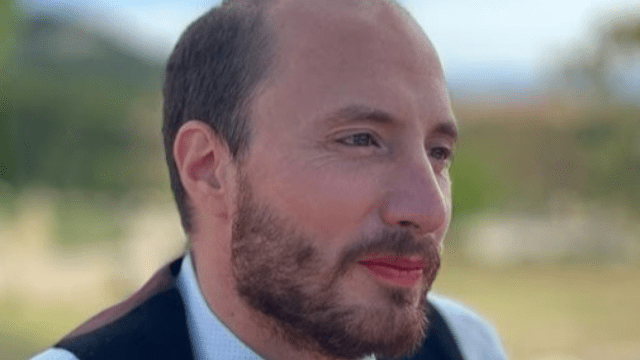Adrien Cascarino (E10): 'Around 1 out of 6 Adolescents Self-Harm'
Adrien Cascarino (E10) has published 'Scarifications : l’adolescent, les parents et les soignants face à l'insupportable' with Éditions Érès. This work draws on his experience in the field as a clinical psychologist and aims not only to improve care for the people concerned, but also to support those who work with them.
ESSEC Alumni: What led you to write study self-harm?
Adrien Cascarino: During my teenage years, I met and sometimes befriended many people who regularly and superficially cut themselves. I was both worried and disturbed, but also sometimes fascinated by their marks, their stories and some of what they wrote about these cuts. After ESSEC, I went on to study to become a clinical psychologist, which was a choice in part related to these people I met when I was younger. As a clinician, I work with teenagers and realise that many of them self-harm too, but don't dare to talk about it because they are afraid of how their loved ones will react. To gain a better understanding of what goes on around these acts and to get another new perspective, I put on my sociologist hat and spent a year of observation in the adolescent psychiatry department of the Institut Mutualiste Montsouris. I interviewed healthcare professionals, teenagers and their parents, which led to a thesis, which I defended in late 2020, and then to this book.
EA: Is self-harm a widespread phenomenon?
A. Cascarino: According to recent statistics, around 1 in 6 teenagers worldwide has already self-harmed,1 and the number of teenagers hospitalised in France for self-harm has risen by 60% since the COVID crisis.2
EA: What are the main profiles impacted?
A. Cascarino: Contrary to popular belief, self-harm is not limited to girls. In fact, only two thirds are girls – one third are boys.
EA: What mechanisms lead to self-harm?
A. Cascarino: That's a huge question! The reasons why teenagers self-harm are extremely varied and change over time. At first, some may self-harm to 'see what it's like' or to mimic something that they have seen or heard about elsewhere or to punish themselves for having failed at something. Then, one might continue to self-harm for the physical sensations brought about by the rush of endorphins or out of defiance towards parents who have 'absolutely forbidden' them from self-harming again. Issues of control over the body, crying out for help, 'proof' of suffering, punishment, pleasure, experimentation and soothing anxiety often come up, but not for everyone and not all the time. It's also worth noting that many people who self-harm change what they say depending on what they perceive of the person they're talking to. Several adolescents told me that they liked seeing their blood, maybe even made drawings with it, but that they avoided talking about it because when they told other people, they were called 'mad' or were told to keep quiet.
EA: Why did you choose to go deeper into this topic?
A. Cascarino: I made three observations. Firstly, the psychiatric and psychological discussions on self-harm do not correspond to what adolescents themselves say. Secondly, there is sociological literature that is very critical of the psychological theories on self-harm. Thirdly, the people confronted with adolescents who self-harm (mainly parents and healthcare professionals) often report that they feel they are in a difficult position when faced with these situations and that their reactions and feelings are disproportionate to the morbid risks involved. So, I decided to look at what goes on psychologically between an adolescent who is self-harming and an adult who is supposed to be looking after them, in the hope that this will lead to better care.
EA: In your work, you begin by reviewing the history of the study of self-harm...
A. Cascarino: And there's a lot to take away from this introduction! For example, the first study in France to look at the subject concerned soldiers who cut their skin, and its aim was to determine who should be regarded as 'insane' and who should be seen as 'chancers' simply trying to avoid service. This distinction is still found today: parents and carers often separate cases of self-harm into 'thought-out' acts, indicating a reprehensible attempt at manipulation, or an 'unthought-out' act indicating suffering and a psychological deficiency requiring treatment. Another, similar historical trace is the highly gendered representation of those who self-harm, as I discussed before. This cliché goes back to the 1960s, when several English and American psychiatrists published nine articles in which they describe those who self-harm as seductive, intelligent young women who are sometimes overcome by their emotions, which is a nod to the caricature of the 'hysteric'. Of course, all these psychiatrists were men who were comfortable telling these young women how to better handle their emotions and 'respect their bodies'. These studies, which often knowingly excluded all the cases involving men, are still being echoed today. I often hear caregivers disappointed that a young woman is self-harming because she has a 'beautiful body' and will be uncomfortable going to the beach!
EA: Beyond this historical context, your argument revolves around your experience on the field today. What observations do you make?
A. Cascarino: The interviews and observations I've been able to make in the field tend to show that the tense relationship between healthcare providers or parents and teenagers often revolves around the issue of control over the body. The treatment of self-harm raises two very sensitive issues. Firstly, to whom does the adolescent's body belong – and what are they allowed to do to it? Secondly, how can we care for someone who says that they find some form of relief in cutting themselves?
EA: How do you answer these questions?
A. Cascarino: What I demonstrate in my book is that self-harm often persists when we try to answer these two questions too quickly. For example, when caregivers tell the teenager that they know better what is good for them and that the teenager should listen to them and stop cutting themselves. But the opposite as well, when parents tell their child that they can do what they want and that it isn't the parents' problem. Helping someone who is self-harming means first accepting that there is no obvious answer, and also agreeing to listen to what the person has to say about it.
EA: How can we explain that no study has ever taken this viewpoint before?
A. Cascarino: Most studies on the topic have focused on the people who self-harm and totally ignore the observers' role. Having listened to adolescents who self-harmed, often friends, first when I was younger and then as a psychologist and finally as a researcher, has probably helped give me some distance.
EA: What conclusions do you draw from your observations?
A. Cascarino: Caregivers and parents need to talk! During the interviews, caregivers spoke to me in great detail of self-harm cases they had seen ten years ago and still remembered, and parents said they were 'devastated' by their child's self-harm. Caring for adolescents who self-harm entails being confronted with the sight of blood and caring for wounds, and it leads to a feeling of powerlessness in the face of being unable to prevent injury. Some cannot handle it. I have seen caregivers disengage from the relationship or, even worse, try to dissuade the adolescent from carrying on no matter the cost, even suturing wounds without anaesthetic.
EA: Given your experience, what solutions do you recommend?
A. Cascarino: Organisationally speaking, we need to establish discussion spaces for caregivers and parents who are confronted with adolescents who self-harm. Relationship-wise, working with adolescents means always questioning what it means to 'take care', giving up on any notion of being all-powerful and controlling another's body – which is often how the caregiver or parent's role is represented – and accepting not just that stopping self-harm is a long process but also that the decision ultimately lies with the person themselves. Finally, at the societal level, we would do well to better inform the public of the reasons for self-harm by disseminating more accounts from sociology. Also, we must keep in mind that a good portion of people who self-harm will not see a psychologist and will stop by themselves after a few months or years.
EA: Does what you say apply just to France, the scope for your study? Or does it apply universally?
A. Cascarino: My arguments are based on numerous European and American studies, but probably do not have the same relevance in other contexts, particularly in countries where body marks may have a sociocultural component – for example, ritual scarification still exists in West Africa, although the practice is becoming less frequent.
EA: What resources would you recommend to ESSEC alumni looking for more information on this topic?
A. Cascarino: I recommend this summary sheet (in French) drawn up by a general practitioner, this article (in French) I wrote on the care of a teenage girl who self-harms, this article by a sociology researcher who self-harmed when she was younger, this article by another sociologist who interviewed many of those affected in France, and finally La Peau et la trace (Éditions Métailié) by David Le Breton, a book which admittedly dates from 2003 but which contains many accounts from teenagers and which has the advantage of being both short and accessible.
1 F. Moloney et al. 'Sex Differences in the Global Prevalence of Nonsuicidal Self-Injury in Adolescents: A Meta-Analysis', JAMA network open, 2024, 7, 6.
2 J-B. Hazo et al. 'Hospitalisations pour geste auto-infligé : une progression inédite chez les adolescentes et les jeunes femmes en 2021 et 2022 ', Études et résultats (DREES), 2024, 1300.
Interview by Louis Armengaud Wurmser (E10), Content Manager at ESSEC Alumni
Do you want more quality content about the ESSEC community? Join us now!

comments0
You don't have the rights to read or add a comment.
Suggested Articles


